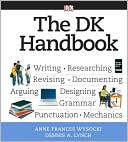The DK Handbook
Search in google:
Transforming student and instructor expectations for textbooks, The DK Handbook presents information in newly accessible, scientifically tested, and student-friendly ways.Never before seen in the handbook market, The DK Handbook’s design is a true marriage of visual and textual content, in which each topic is presented in self-contained, two-page spreads for at-a-glance referencing. Explanations are concise and “chunked” to be more approachable and appealing for today’s readers, and accompanying visuals truly teach – making concepts and processes visible to students. The ground-breaking layout creates a consistent look and feel that helps students connect with the material, find information, and recognize solutions to writing problems they often don’t have names for.
1. A PROCESS FOR COMPOSINGWhat is composing?What is rhetoric?AudiencePurposeContextStrategiesRhetoric and a process for composing a research paperUnderstanding your project or assignment2. FINDING IDEASComposing to learn and composing to communicateA research processGetting started with researchFinding a topicNarrowing a topicHow do you know when you have a narrowed topic?Other strategies for narrowing a topicQuestions to guide researchUsing research questions to develop a topicKinds of sources, kinds of researchKinds of researchDetermining where to researchChoosing sourcesChoosing sources–booksChoosing sources–periodicalsChoosing sources–webpagesFinding sourcesLibrary researchUsing library indexesUsing library catalogsUsing library journal databasesSteps in using databasesOnline researchSearch engines and directoriesOnline referencesOnline newspapersGovernment sourcesArchival and special collection sourcesField research sourcesInterviewsObservationsSurveysWhat if you can’t find anything on your narrowed topic?Keeping track of sourcesStarting a paper3. ANALYZING ARGUMENTS AND EVALUATING SOURCESWhat is analysis?Understanding and analyzing textsDeveloping a sense of the authorUnderstanding appeals to emotionUnderstanding arrangement and logicA sample analysis essayAnalyzing argumentsThesis statementsWhat counts as evidence?Expert testimonyPersonal experienceAnalogiesFactsField researchShared valuesExamplesFurther questions to guide critical readingCritical readingSample argumentative essayA sample rhetorical analysisQuestions to guide critical lookingA sample analysis of a visual textEvaluating sourcesEvaluating sources for relevanceSample sourcesEvaluating sources for credibility: PrintSample sourcesEvaluating sources for credibility: OnlineSample sourcesResearching ethicallyShared culture, academic research, and fair useDeveloping a thesis statement4. CONNECTING WITH AUDIENCESUnderstanding your audienceCharacteristics your audience might shareWhat do people know, think, and feel about the issue?Making audiences real and specificSome complexities of audienceDeveloping a statement of purposeStarting to write for an audienceHow to write a statement of purposeChoices a writer can make based on a statement of purposeA sample rough draftDeveloping a revision planWriting for different kinds of audiencesAcademic audiencesWorkplace audiences5. ORGANIZING AND SHAPING TEXTSWhat is organization?Organization and mediumOrganization, audience, and genreOnline genresEmailBlogs and other social networking websitesPopular genresLetters to the editorLetters of complaintMagazine articlesAcademic genres in the disciplinesWriting in the humanitiesWriting in the sciencesWriting in the social sciencesWorkplace genresMemosResumesCover lettersShaping paragraphs for audience and purposeUnified and coherent paragraphsParagraphs that developParagraphs that describeParagraphs that defineParagraphs that narrateParagraphs that give examplesParagraphs that use analogyParagraphs that divideParagraphs that blend organizationsVisual organizationMajor elements of texts that mix words, pictures, and other visual piecesBuilding visual organizationsMake some elements stand outGroup elements or make them similarAlign elementsOrganization for oral presentationsThe parts of an oral presentationOther organizational featuresFiguring out what to do with a paragraph that is too long6. WRITING FOR DIVERSE AUDIENCESVarieties of EnglishLanguage standardization and language varietyAcademic EnglishEnglish as a global languageWriting English when English is not your home languageWriting as a second languageMultilingual writers writing in EnglishUsing inclusive languageHow do you show respect for your readers?Including all ethnicitiesIncluding all agesIncluding all gendersIncluding all abilitiesIncluding all sexual orientationsIncluding all religionsUsing an ESL dictionary7. COMPOSING WITH STYLEStyle and audienceStyle in writingClarity, concision, coherence, emphasis, engagementStyling wordsDictionary definitions and associationsThe names we useAction verbsConcrete nounsClichésJargonToo many wordsStyling sentencesAcademic sentencesSentences that are easy to readUsing coordination and subordinationParallelismFigurative languageStyling paragraphsConcluding paragraphsIntroductory paragraphsTransitions between paragraphsPassive voiceStyle in visual textsTypographyHeadingsColorStyle in oral presentationsBody language and gesturesUsing visual supports8. DOCUMENTINGWhy cite and document sources?What is plagiarism?Plagiarism–or misuse of sources?Tips for avoiding plagiarismFour facets of citing and documentingQuoting, summarizing, and paraphrasingQuoting the words of othersSummarizing the words of othersParaphrasing the words of othersFive kinds of sourcesCollecting citation information from printed booksCollecting citation information when you are citing part of a printed bookCollecting citation information when you are citing printed periodicalsCollecting citation information when you are citing webpagesCitation information for databases to journalsCollecting citation information for other kinds of sourcesMLA DocumentationMLA documentation for in-text citationsVariations on the patternMLA documentation for works citedFor booksFor parts of booksFor articles from periodicalsFor webpages other than databasesFor texts from online databasesFor other kinds of textsAuthor’s nameTitlesWebsite titlesA very long URLPlace of publicationYear of publicationPeriodical volume and datePage numbers for articles from periodicalsAdditional informationA works cited page in MLA formatFor other kinds of textsSample paper in MLA formatGuide to MLA documentation modelsAPA DocumentationAPA documentation and in-text citationsVariations on the patternAPA documentation for reference list entriesFor periodical sourcesFor nonperiodical sourcesAuthor's nameYear of publicationTitlesAdditional informationPlace of publicationPeriodical volume and issueFor online textsFor other kinds of sourcesA references page in APA formatGuide to APA documentation modelsCSE DocumentationCSE referencesCSE in-text citationsDetails of the patternsCSE sample referencesChicago Manual of Style documentation and in-text citationsCMS in-text citations and footnotesCMS sample references9. EDITING AND PROOFREADING YOUR WORKEditing and proofreadingGrammar There are 4 sentence functionsThere are 4 sentence patternsSimple sentences 1 / 2Simple sentences 3Subjects and predicatesMore on predicatesCompound subjects and predicatesPrepositional phrasesCompound sentencesComplex sentences: Working with independent and dependent clausesComplex sentences with adverb clausesCompound-complex sentencesAvoiding sentence fragmentsAvoiding run-on sentencesParts of speechNounsPronounsChoosing the expected personal pronounPronoun agreementAdjectivesArticlesVerbsThe tenses of English verbsUsing the tenses of English verbs in academic writingShifting verb tensesSubject-verb agreementThe subjunctive mood of English verbsAdverbsPrepositionsConjunctionsAvoiding shifts in grammatical formsShifts in person and numberShifts in voiceShifts in levels of formalityAvoiding misplaced and dangling modifiersPunctuationCommasWith numbers, place names, and datesWhen you are quoting the words of othersTo separate words in listsTo build sentences with multiple partsWhen not to use commasSemicolonsTo separate the ideas in a listTo join two sentencesColonsIn certain conventional pattermsTo prepare readers for information at the end of a sentenceTo link two sentencesParenthesesTo explain abbreviationsFor numbers in listsFor in-text citationsTo add informationDashesBracketsHyphensSlashesEllipsesQuotation marksFor titles of short worksTo indicate you are using a word as a wordTo indicate technical termsTo show ironyTo indicate direct quotationTo indicate speechApostrophesPeriodsQuestion marksExclamation pointsMechanicsUsing italics and underliningSpellingUsing spell checkersCapitalizing wordsAbbreviationsNumbersGlossary of grammatical terms and usage








